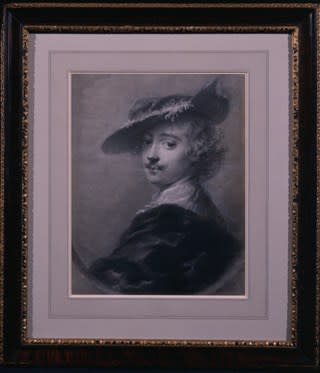
Herman van der Mijn
Self Portrait, 1740s
Pastel on paper
12 x 9 ½ in. (29.5 x 24.2 cm)
Philip Mould & Co.
To view all current artworks for sale visit philipmould.com This engaging chalk and charcoal drawing by Van Der Mijn is thought to be a self-portrait of the artist. The...
To view all current artworks for sale visit philipmould.com
This engaging chalk and charcoal drawing by Van Der Mijn is thought to be a self-portrait of the artist. The direct glance suggests this, as does the costume in which the artist chooses to portray himself. It is not the historicised fancy dress familiar in the English school of the eighteenth century as ''Vandyke dress.'' It is instead a close imitation of the dress worn in self-portraits by artists of Rembrandt's school in the previous century. It is as fictitious, therefore, as Vandyke dress, but its references are different. It alludes not to a life and art of courtly ease, but to the painter examining himself as a man of genius. The contrivance is absolute, even to the moustache that the sitter wears, which is a convention of the 1660s in Amsterdam, but unlikely in a court painter of the early eighteenth century. Others were to allude to Rembrandt in self-portraiture -Reynolds not least in his self-portraits in the robes of a Doctor of Civil Law in 1780 - but Van der Mijn's drawing reminds us that he studied in Amsterdam when the memory of Rembrandt was still alive.
Herman van der Mijn was a pupil of Ernst Stuven (1660-1712), and lived in Amsterdam, then in Antwerp (1712-13) and finally in Düsseldorf, where he worked for the Elector Palatine, until the Prince died in 1716. He then returned to Antwerp, before working in Paris, where he gained the patronage of he Duke d'Orleans until invited to London in 1721. He was favoured by the Earl of Exeter, Lord Cadogan and Sir Gregory Page, and established a prosperous practice, particularly in the execution of small portraits. Despite gaining the patronage of Queen Caroline in 1727, his extravagant lifestyle and large family -several of whom, George, Gerard and Robert became painters in succession to their father- ultimately became resulted in great debts. This association was severed temporarily when one of his paintings was refused in 1727/8 but, happily for the artist's stricken finances, restored upon the arrival of Prince William IV of Orange Nassau. He went with the Prince and Princess to the Netherlands, and he was working at the palace of Het Loo in 1736. Apparently, he soon fell out of favour with his patron and returned to London, where he died.
This engaging chalk and charcoal drawing by Van Der Mijn is thought to be a self-portrait of the artist. The direct glance suggests this, as does the costume in which the artist chooses to portray himself. It is not the historicised fancy dress familiar in the English school of the eighteenth century as ''Vandyke dress.'' It is instead a close imitation of the dress worn in self-portraits by artists of Rembrandt's school in the previous century. It is as fictitious, therefore, as Vandyke dress, but its references are different. It alludes not to a life and art of courtly ease, but to the painter examining himself as a man of genius. The contrivance is absolute, even to the moustache that the sitter wears, which is a convention of the 1660s in Amsterdam, but unlikely in a court painter of the early eighteenth century. Others were to allude to Rembrandt in self-portraiture -Reynolds not least in his self-portraits in the robes of a Doctor of Civil Law in 1780 - but Van der Mijn's drawing reminds us that he studied in Amsterdam when the memory of Rembrandt was still alive.
Herman van der Mijn was a pupil of Ernst Stuven (1660-1712), and lived in Amsterdam, then in Antwerp (1712-13) and finally in Düsseldorf, where he worked for the Elector Palatine, until the Prince died in 1716. He then returned to Antwerp, before working in Paris, where he gained the patronage of he Duke d'Orleans until invited to London in 1721. He was favoured by the Earl of Exeter, Lord Cadogan and Sir Gregory Page, and established a prosperous practice, particularly in the execution of small portraits. Despite gaining the patronage of Queen Caroline in 1727, his extravagant lifestyle and large family -several of whom, George, Gerard and Robert became painters in succession to their father- ultimately became resulted in great debts. This association was severed temporarily when one of his paintings was refused in 1727/8 but, happily for the artist's stricken finances, restored upon the arrival of Prince William IV of Orange Nassau. He went with the Prince and Princess to the Netherlands, and he was working at the palace of Het Loo in 1736. Apparently, he soon fell out of favour with his patron and returned to London, where he died.
Be the first to hear about our available artworks
* denotes required fields
We will process the personal data you have supplied in accordance with our privacy policy (available on request). You can unsubscribe or change your preferences at any time by clicking the link in our emails.